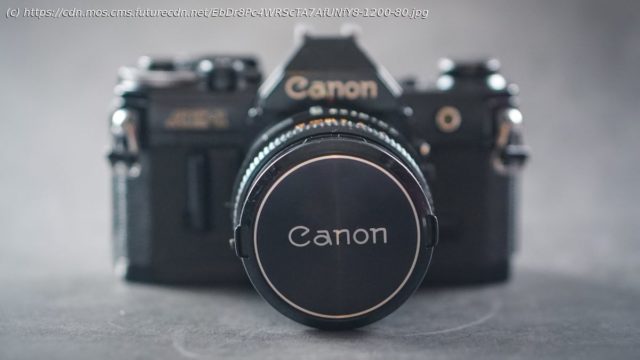The Canon EOS R3 might be king of the pile right now, but how did Canon get here?
It’s already been a pretty momentous year for Canon. In March, its Canon EOS system – which kicked off in 1987 with the Canon EOS 650 – celebrated its 35th birthday. And last month, we saw the arrival of the Canon EOS R7 and EOS R10, two mirrorless cameras that are both powerful and pretty affordable. But despite the global domination of its EOS brand, Canon’s history spreads much farther and wider than its ‘Electro Optical System’. So we’ve decided to gaze back through time and pick out what we think are the best Canon cameras from its 84-year history. After all, if there’s one thing that gets our heart rate going more than a new camera, it’s an old camera. Also, if there’s one company whose product history tracks the development of modern photography from the very earliest days of photography’s mass-market appeal to the very, very recent past, it’s Canon. From its 1934 Canon Hansa (let us know if you’ve got one mouldering in a cupboard; they’re selling for about $7,000 / £7,000) to the EOS R7, Canon cameras have documented two World Wars, 20 Olympic Games, hundreds of world leaders and countless family memories. From cameras that worked without batteries to today’s supercomputers-with-a-lens, tracing Canon’s lineage is to trace photographic history – and consumer and professional tastes. Here, we’ve lined up 10 of the company’s most notable cameras, both from the world of film and the days of digital. How many have you owned – and which would you add to our list? Plus ça change. There was a 23-year gap between the Canon EOS 3 and the next-gen Canon EOS R3, but while Canon’s line-up of high-end cameras was slightly the poorer for the want of a 3-series digital camera, the EOS 3 is an interesting product that tied together Canon’s professional and amateur cameras. First, the specs: this was a 35mm camera noteworthy, first and foremost, for its autofocus system, which boasted enough tricks you could slap a pointy hat on it and call it a wizard. Outside of the EOS-1 range of top-end cameras, it had the most sophisticated autofocus system of any of Canon’s cameras, whether digital or film, until the EOS 5D Mark III. With 45 autofocus points spread across the frame, it allowed a huge amount of compositional flexibility. Not only that, the EOS 3 was Canon’s last camera to allow for eye-control AF, in which you could direct it to use a particular autofocus point by simply looking at the area in the frame while you were looking through the viewfinder. That’s a feature that promptly went AWOL from all of Canon’s cameras until the EOS R3. That wasn’t all. Further bolstering the EOS 3’s professional credentials was its ability to shoot 4.3 frames per second with its integrated film winding motor; you could bump this to 7fps if you attached the optional Canon Powerdrive Booster. Perhaps most interestingly – at least to tedious camera nerds like us – is the number of similarities the EOS 3 shares with nearly all of the Canon high-end digital cameras that followed. The mount was consistent until the RF mount came in, of course, but so were the control layouts, the autofocus functionality, the way shooting data was presented in the optical viewfinder and far more. It was this consistency, as much as it was image quality and lens choice, that ensured photographers were able to comfortably navigate the sea-change from film to digital – the EOS 3 is emblematic of that. A moment of silence and a tip of the hat to our dear departed compact camera brethren. Born from the ashes of the point-and-shoot film market, compact digital cameras – such as the PowerShot G1 but also the Canon Ixus range – are now all-but dearly departed, usurped by smartphones from below and ever-more capable mirrorless cameras from above. Back in the year 2000, the PowerShot G1 became a big reason (literally and figuratively) why digital cameras enjoyed such widespread appeal. It wasn’t cheap, but compared to digital SLRs, it represented a more-or-less affordable way to get into high-end digital photography. It had a 1/1.8in CCD sensor with 3.24 megapixels, and could shoot apertures between 50 and 400. Of interest to ambitious photographers was the inclusion of a manual mode, while the 3x optical zoom (34-102mm converted to 35mm focal lengths, fact-fans) gave plenty of flexibility considering you couldn’t detach the lens. The hotshoe on the top was the final great touch, allowing photographers to begin to get to trips with “proper” flashguns. It could also shoot raw images as well as JPEGs. There were even a few touches that were positively futuristic, such as the vari-angle screen, as well as some that disappointingly vanished as the compact digital camera developed. We’re thinking in particular here of the top-mounted LCD screen that displayed current shooting information, allowing users to set their camera up – and indeed compose their image via the optical viewfinder – without resorting to the battery-draining, 1.8in rear-mounted screen. So desirable that, as of summer 2022, you can’t actually buy one, the EOS R3 is what happens when a company with Canon’s legendary resources throws absolutely everything at a single product. Canon’s top-end pro models have long been the stuff of dreams for professional and amateur photographers alike – whether the original EOS-1D X, the 1D X Mark III or the EOS 5D – and the EOS R3 will be featuring in the wildest dreams of many a photographer, irrespective of the genre they shoot in. There are headline specs to shout about, of course: stick to the mechanical shutter and the EOS R3 will shoot full-frame 24.1MP shots at a clip of 12fps, or 30fps with the electronic shutter. ISO sensitivity runs to a dizzying maximum of 204,800, and like the EOS R5 and R6, the R3 has a positively bonkers autofocus system capable of accurately tracking people, vehicles and animals in all kinds of light. Of course, it shoots video as well – in this case up to 12-bit, 6K RAW or 10-bit 4K. So far so good, but there’s also the small matter of build-quality. For decades, Canon has produced cameras that could be used to bang in nails, and the R3 – significantly more so than the R6 or R5 – continues that legacy. Dust, water and shock-proofing are all in evidence here, and it’s also Canon’s first full-height (that is, with an integrated grip) mirrorless camera.






